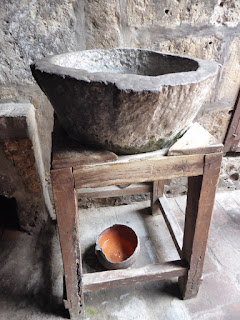On the Arequipa tour was an hour-long visit to the convent of Saint Catalina, virtually a city within a city in the old days. In those old days, the second daughter had to go to the convent, unless the second son became a priest. Actually, it was more complicated than that. Many women no doubt thought the convent preferable to marriage anyway or a life in times of unrest, revolution, etc. Anyhow, it appeared to be a really big convent. Alas, the more we learned, the less we were impressed. It was a convent for the wealthy, virtually a collection of small houses, apartments, etc. You could bring your servants with you. They did the cooking, washing, cleaning, lived upstairs. You ate off your family's fine silver and china. All this changed in 1861, our guide said, leaving us to wonder what exactly happened in 1861. Was the surrender of Fort Sumter somehow connected with the convent system? The Bankruptcy and Insolvency Act in Great Britain? Or maybe it had something to do with the richly deserved diminution of the Church, Italian unification, Garibaldi, Victor Emmanuel, et al. Anyhow, we toured the convent. But everything had changed after 1861. It's now run by the city, although 16 nuns still live there, dormitory style and support themselves via a gift store and tea shoppe.
 |
Once you were in, there was no contact with the outside world
except through this latticed window (well, except for your
servants, who had plenty of contact, etc.) |
 |
Any gifts had to pass through this revolving
door |
 |
| Typical square |
 |
| In the novitiate area, instructional paintings |
 |
| Novitiate's bed chamber |
 |
| Novitiate cloisters |
 |
| Chapel |
 |
| Funeral chapel |
 |
| All the deceased painted with eyes closed |
 |
Except this lady, who died the evening before,
and was not discovered until the next day;
rigor mortis had set in, and they couldn't
get her eyes closed; I guess it was against
the rules to paint her eyes closed... |
 |
| Now in the regular, that is, non-novitiate, convent; sitting room |
 |
| Bed chamber |
 |
| Musical instrument from home |
 |
| Kitchen |
 |
| Oven; stairs leading to servants' quarters |
 |
| Nicely landscaped |
 |
The white tufa is a marvelous water filter, here
in use |
 |
| The whole place is done in red, white, and blue, and orange |
 |
Streets named after back home; I doubt that many of these
ladies were mestizos |
 |
| Another sitting room |
 |
| Nice china, silver |
 |
| Tea shoppe |
 |
| Servants' laundry area |
 |
| Spare baskets |
 |
Shrine to Sister Ana, beatified in the 80s;
sainthood pending... |

























No comments:
Post a Comment